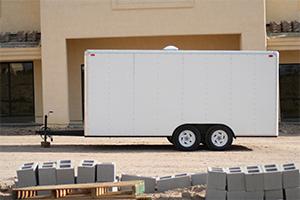Best practices for managing fleet safety

Your fleet of vehicles is an important asset to your company operations, and has significant exposure to loss and production expectations. Whether driving pickup trucks or heavier DOT-regulated trucks, it is essential to develop a risk management approach to minimize vehicles’ crash potential.
Think of your fleet as two separate risks: the driver and the vehicle itself. Each needs maintenance and proper attention to control unwanted incidents. While the lists below do not include all possible risks, they form a good platform for your own fleet risk assessment to help avoid injuries, property damage and liability losses.
Driver risk
The lists below include common vehicle operation risks, as well as links to The Hanover resources to help you manage that risk.
- Establish a written fleet safety program that includes a distracted driving policy
- Provide training to all drivers
- Assess effectiveness of your fleet safety program
- Perform frequent — at least annually — MVR checks on all drivers
Vehicle risk
The list below includes best practice tips to monitor and maintain fleet operations, and links to The Hanover resources that can help you manage that risk.
- Review your SMS report for DOT-registered vehicles
- Develop a pre-trip inspection process and train workers on proper load securement methods
- Ensure maintenance schedules are followed and drivers are instructed to report any problems immediately
Your Hanover resources
Hanover policyholder benefits include not only our comprehensive coverage, but also access to risk solutions partner services, including:
- Equipment theft prevention and recovery products
- Background check services
- Disaster and recovery planning services
- Industry-specific training resources
- Alarm system testing and maintenance services
- Automatic sprinkler testing and maintenance services
Visit our Hanover auto safety page.
This material is provided for informational purposes only and does not provide any coverage or guarantee loss prevention. The examples in this material are provided as hypothetical and for illustration purposes only. The Hanover Insurance Company and its affiliates and subsidiaries (“The Hanover”) specifically disclaim any warranty or representation that acceptance of any recommendations contained herein will make any premises, or operation safe or in compliance with any law or regulation. By providing this information to you, The Hanover does not assume (and specifically disclaims) any duty, undertaking or responsibility to you. The decision to accept or implement any recommendation(s) or advice contained in this material must be made by you.
LC 2017-408
Related resources
Best practices for managing fleet safety
Your fleet of vehicles is an important asset to your company operations, and has significant exposure to loss and production expectations. Whether driving pickup trucks or heavier DOT-regulated trucks, it is essential to develop a risk management approach to minimize vehicles’ crash potential.
Think of your fleet as two separate risks: the driver and the vehicle itself. Each needs maintenance and proper attention to control unwanted incidents. While the lists below do not include all possible risks, they form a good platform for your own fleet risk assessment to help avoid injuries, property damage and liability losses.
Driver risk
The lists below include common vehicle operation risks, as well as links to The Hanover resources to help you manage that risk.
- Establish a written fleet safety program that includes a distracted driving policy
- Provide training to all drivers
- Assess effectiveness of your fleet safety program
- Perform frequent — at least annually — MVR checks on all drivers
Vehicle risk
The list below includes best practice tips to monitor and maintain fleet operations, and links to The Hanover resources that can help you manage that risk.
- Review your SMS report for DOT-registered vehicles
- Develop a pre-trip inspection process and train workers on proper load securement methods
- Ensure maintenance schedules are followed and drivers are instructed to report any problems immediately
Your Hanover resources
Hanover policyholder benefits include not only our comprehensive coverage, but also access to risk solutions partner services, including:
- Equipment theft prevention and recovery products
- Background check services
- Disaster and recovery planning services
- Industry-specific training resources
- Alarm system testing and maintenance services
- Automatic sprinkler testing and maintenance services
Visit our Hanover auto safety page.
This material is provided for informational purposes only and does not provide any coverage or guarantee loss prevention. The examples in this material are provided as hypothetical and for illustration purposes only. The Hanover Insurance Company and its affiliates and subsidiaries (“The Hanover”) specifically disclaim any warranty or representation that acceptance of any recommendations contained herein will make any premises, or operation safe or in compliance with any law or regulation. By providing this information to you, The Hanover does not assume (and specifically disclaims) any duty, undertaking or responsibility to you. The decision to accept or implement any recommendation(s) or advice contained in this material must be made by you.
LC 2017-408
Related resources
Best practices for managing fleet safety
Your fleet of vehicles is an important asset to your company operations, and has significant exposure to loss and production expectations. Whether driving pickup trucks or heavier DOT-regulated trucks, it is essential to develop a risk management approach to minimize vehicles’ crash potential.
Think of your fleet as two separate risks: the driver and the vehicle itself. Each needs maintenance and proper attention to control unwanted incidents. While the lists below do not include all possible risks, they form a good platform for your own fleet risk assessment to help avoid injuries, property damage and liability losses.
Driver risk
The lists below include common vehicle operation risks, as well as links to The Hanover resources to help you manage that risk.
- Establish a written fleet safety program that includes a distracted driving policy
- Provide training to all drivers
- Assess effectiveness of your fleet safety program
- Perform frequent — at least annually — MVR checks on all drivers
Vehicle risk
The list below includes best practice tips to monitor and maintain fleet operations, and links to The Hanover resources that can help you manage that risk.
- Review your SMS report for DOT-registered vehicles
- Develop a pre-trip inspection process and train workers on proper load securement methods
- Ensure maintenance schedules are followed and drivers are instructed to report any problems immediately
Your Hanover resources
Hanover policyholder benefits include not only our comprehensive coverage, but also access to risk solutions partner services, including:
- Equipment theft prevention and recovery products
- Background check services
- Disaster and recovery planning services
- Industry-specific training resources
- Alarm system testing and maintenance services
- Automatic sprinkler testing and maintenance services
Visit our Hanover auto safety page.
This material is provided for informational purposes only and does not provide any coverage or guarantee loss prevention. The examples in this material are provided as hypothetical and for illustration purposes only. The Hanover Insurance Company and its affiliates and subsidiaries (“The Hanover”) specifically disclaim any warranty or representation that acceptance of any recommendations contained herein will make any premises, or operation safe or in compliance with any law or regulation. By providing this information to you, The Hanover does not assume (and specifically disclaims) any duty, undertaking or responsibility to you. The decision to accept or implement any recommendation(s) or advice contained in this material must be made by you.
LC 2017-408
Related resources
Best practices for managing fleet safety
Your fleet of vehicles is an important asset to your company operations, and has significant exposure to loss and production expectations. Whether driving pickup trucks or heavier DOT-regulated trucks, it is essential to develop a risk management approach to minimize vehicles’ crash potential.
Think of your fleet as two separate risks: the driver and the vehicle itself. Each needs maintenance and proper attention to control unwanted incidents. While the lists below do not include all possible risks, they form a good platform for your own fleet risk assessment to help avoid injuries, property damage and liability losses.
Driver risk
The lists below include common vehicle operation risks, as well as links to The Hanover resources to help you manage that risk.
- Establish a written fleet safety program that includes a distracted driving policy
- Provide training to all drivers
- Assess effectiveness of your fleet safety program
- Perform frequent — at least annually — MVR checks on all drivers
Vehicle risk
The list below includes best practice tips to monitor and maintain fleet operations, and links to The Hanover resources that can help you manage that risk.
- Review your SMS report for DOT-registered vehicles
- Develop a pre-trip inspection process and train workers on proper load securement methods
- Ensure maintenance schedules are followed and drivers are instructed to report any problems immediately
Your Hanover resources
Hanover policyholder benefits include not only our comprehensive coverage, but also access to risk solutions partner services, including:
- Equipment theft prevention and recovery products
- Background check services
- Disaster and recovery planning services
- Industry-specific training resources
- Alarm system testing and maintenance services
- Automatic sprinkler testing and maintenance services
Visit our Hanover auto safety page.
This material is provided for informational purposes only and does not provide any coverage or guarantee loss prevention. The examples in this material are provided as hypothetical and for illustration purposes only. The Hanover Insurance Company and its affiliates and subsidiaries (“The Hanover”) specifically disclaim any warranty or representation that acceptance of any recommendations contained herein will make any premises, or operation safe or in compliance with any law or regulation. By providing this information to you, The Hanover does not assume (and specifically disclaims) any duty, undertaking or responsibility to you. The decision to accept or implement any recommendation(s) or advice contained in this material must be made by you.
LC 2017-408






